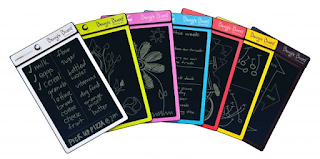The Boogie Board!
Now maybe it’s just me, but “boogie board” makes me think of
the little foam board my cousins and I used to fight over on vacation to the
beach.
Is anyone else picturing something like this?

Up until about 6 months ago, that’s what came to mind for me
as well. That is, until one of my favorite kindergarten teacher blogs (The Kindergarten Smorgasboard) started
posting pictures of his class using their Boogie Boards for writing practice.
I knew immediately I needed to purchase a few of these writing tablets for my classroom. At the time, I was hopeful that I could save enough money to get four or five to utilize at one center. After brainstorming with a teammate, I realized that a class set of Boogie Board would be ideal. I was extremely fortunate that my desperate plea to my school's Parent Teacher Organization was successful. They voted to purchase twenty-four Boogie Boards for my classroom. With a little patience and bargain shopping, and no need for a specific color, I was able to get each Boogie Board for just under $19.00 a piece.
My kindergartners have been using their class set of Boogie Boards to practice
letter writing, number writing, shape drawing, patterning, and addition and I
have been thrilled with their willingness and excitement to complete these activities.
The best part is, Boogie Board writing tablets do not need to be plugged in or charged. They don't even need new batteries. The power needed to operate the Boogie Board is so small, they are expected to last about six years with the original battery. I have been able to eliminate quite a few paper and pencil activities, as well as many personal dry erase board activities that used to be regular routines in my classroom. Not only has it cut back on paper consumption, it has motivated my students tremendously. I've also been really happy to not worry about dry erase markers losing their cap and drying out. My kids transition much more quickly with the Boogie Boards because they are erased with a quick touch of a button.
Overall, my kids love the Boogie Board LCD Writing Tablets just as much as I do! They were eager to use the Boogie Board to write "thank you" notes to PTO as well.
A special thanks to Greg over at The Kindergarten Smorgasboard for posting all about his love for Boogie Boards!




















